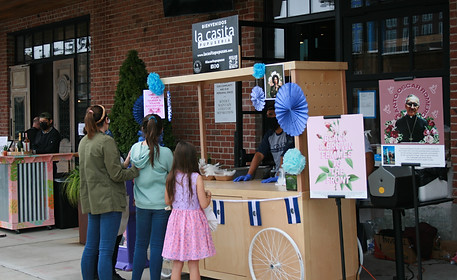
Lisa Marquez, M.A.
Service Designer/UX Researcher
Food for the People: Eating and Activism in Greater Washington Exhibition
Project Overview
What
The COVID-19 pandemic has brought into sharp relief the kinds of inequalities that plague the global, national and local food systems—a central focus of the Anacostia Community Museum’s ongoing research and exhibition project, Food for the People: Eating and Activism in Greater Washington. Production shortages—and rising prices—of meat, legacy food businesses and restaurants facing potential permanent closure from economic pressures, food workers—from farms to food processing/packing facilities to restaurants and grocery stores—facing disproportionate numbers of COVID-19 infections: these are the realities of a global pandemic profoundly impacting not only what we eat and how we get the food we eat, but also the toooften-invisible workers whose labor makes all of our food possible.
When
2020 to 2021
Goal: This project aims to document the impact of inequities of the food system in the Washington, DC region. My specific focus of the research project was to collect interviews of those that identified or supported the Latinx community through their food justice work or efforts, in order to display a robust collection for the exhibition.
Accomplishments: My qualitative research findings contributed to the exhibition receiving the Smithsonian Excellence in Exhibitions Award
Research Setup
Ethnographic Field Research and Recruitment
I began the research project by exploring local neighborhoods with a high concentration of street vendors, Latinx-owned restaurants and stores, and Latinx-centered organizations. Spent extensive time at restaurants and where street vendors sold food products to understand the Latinx food landscape. Additionally, I attended local events held by Latinx-restaurant owners and organizations and volunteered with Latinx-centered organizations to understand the issues DC Latinx populations were experiencing. From my field work, I was able to understand the issues impacting the Latinx community on a deeper level. Additionally, I connected with key participants to be interviewed for the exhibit and curated more impactful questions when conducting the interviews.
Interviews
I conducted 30+ one on one and joint semi-structured interviews with stakeholders in English and Spanish that ranged from twenty minutes to two hours long. I conducted extensive research on policies impacting the work of the stakeholders I was interviewing. I analyzed historical research through museum and news archives of the legacy of the restaurant and store owners, and advocates whom I interviewed.
Secondary Research Collection
Though I conducted interviews with stakeholders across the food system, I still needed to find information that highlights the historical context the food workers I interviewed found themselves in.
That is why I collected desk research that spoke to the historical component of the data from the interviews I was conducting. I connected with stakeholders at other museums and organizations that shared archived videos, photos, and interviews.
Key Finding: From archive findings, I found key information on the imminence of the H-2B program in the Eastern Shore in Maryland. This led to more powerful storytelling of our exhibition when displaying current issues and why food workers under the H-2B program are integral to our food system.
Tomato Race Interactive Activity
Interactive designed for children to understand the inequities food workers experience.
Research Setup
Interviews
I conducted interviews with farmworkers, and farmworker-centered human rights organizations such as the Coalition of Immokalee Workers, United Farm Workers Foundation, and DC Fair Food to gather information on injustices farm workers endure.
Secondary Research Collection
I conducted extensive research prior to the interviews and after to gather accurate information to include in the interactive.
Outcomes:
I collaborated with the design and education team to appropriately present interactive information for children aged audiences.



Subproject: Tomato Race Interactive Activity


